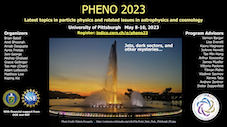Conveners
DM II
- Sandra Robles (Fermilab)
We use a catalogue of stellar binaries with wide separations (up to 1 pc) identified by the Gaia satellite to constrain the presence of extended substructure within the Milky Way galaxy. Heating of the binaries through repeated encounters with substructure results in a characteristic distribution of binary separations, allowing constraints to be placed independent of the formation mechanism...
In this talk, we discuss a baryonic feedback mechanism induced by dark matter ignition of white dwarf populations, and its potential effects on galaxy evolution and star formation. Previous works have shown that Type Ia supernova ignitions of sub-Chandrasekhar white dwarfs may be caused by asymmetric dark matter captured within white dwarfs, leading to the formation and subsequent collapse of...
Dark matter particles can form halos gravitationally bound to massive astrophysical objects. The Earth could have such a halo where depending on the particle mass, the halo either extends beyond the surface or is confined to the Earth's interior. We consider the possibility that if dark matter particles are coupled to neutrinos, then neutrino oscillations can be used to probe the Earth's dark...
Our research focuses on studying the heating mechanism of neutron stars through the capture of inelastic dark matter. Due to the high density of neutron stars, infalling dark matter particles are accelerated to relativistic speeds. To analyze the scattering between ultra-relativistic targets in the neutron star and quasi-relativistic infalling dark matter, we employ relativistic kinematics....
This study investigates the capture and thermalization of inelastic dark matter outside neutron stars. While the possibility of capture, thermalization and annihilation has been studied in some detail in the literature, this has assumed dark matter thermalizes to a trajectory lying inside neutron stars. I will show that some inelastic dark matter models imply thermalization timescales long...
